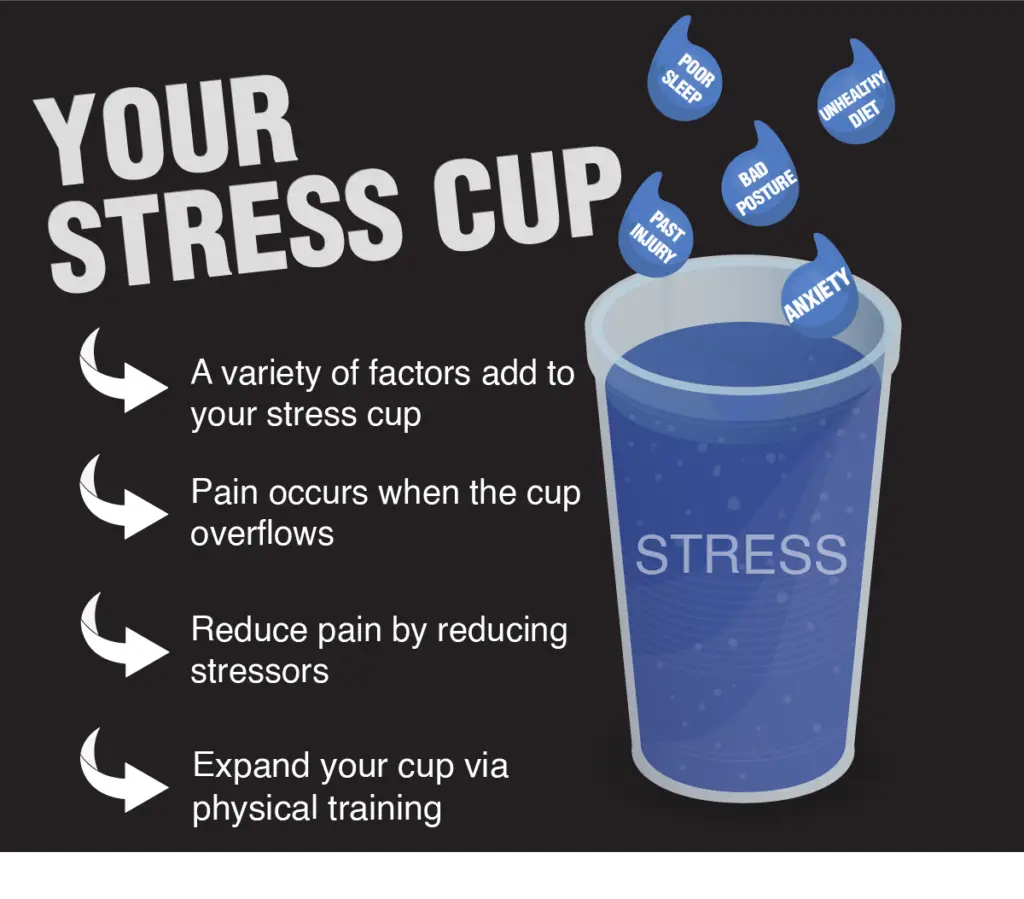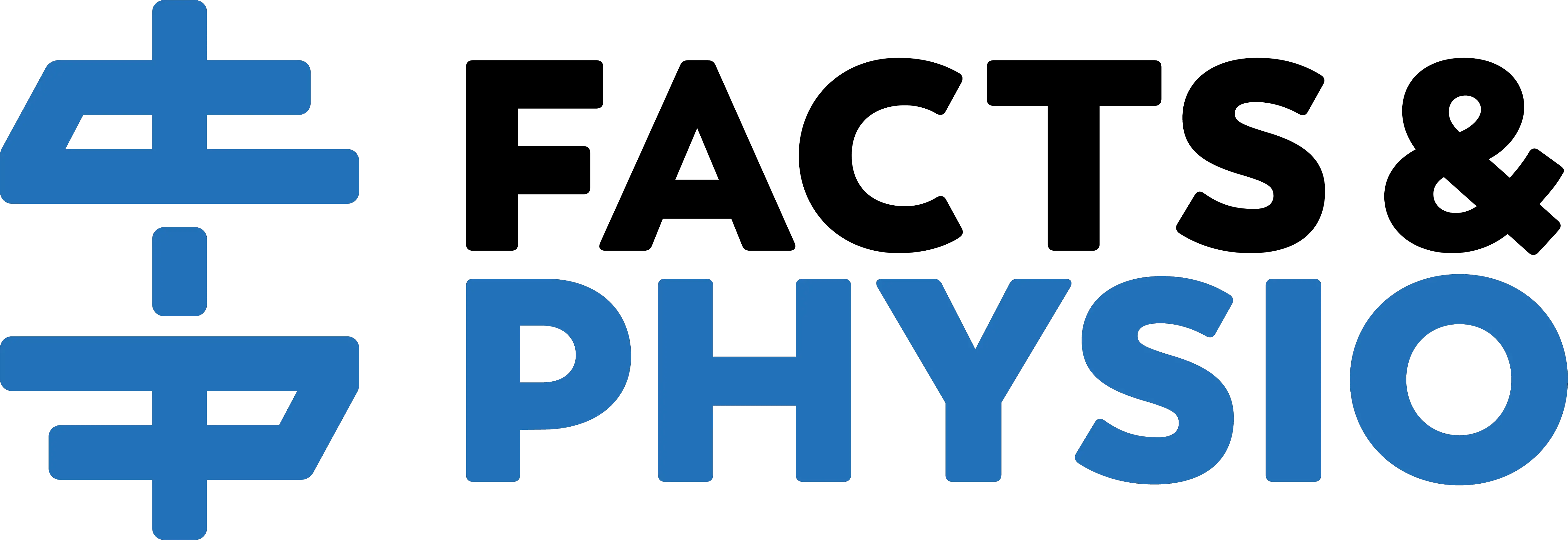TMJ symptoms can be a real pain in the neck. Neck pain and jaw pain are closely intertwined. Many people with neck pain suffer from TMJ issues, and vice versa.

What Causes TMJ and Neck Pain?
Pinpointing the precise cause of TMJ and neck pain is difficult. Pain is complex and stems from a combination of factors. Risk factors for neck pain and temporomandibular joint disorder (TMD) include (1):
- Trauma (like a jaw dislocation or concussion)
- Headaches
- Tight neck muscles
- Sore jaw muscles
- Bruxism (teeth-grinding)
- Rheumatoid arthritis
Other factors like stress, poor sleep, chronic pain, and obesity also amplify TMJ pain and neck problems. The “stress cup” analogy describes the multi-factorial nature of pain:

A Common Misnomer
TMJ stands for temporomandibular joint. To indicate a jaw problem, the term “TMJ” should be followed by “pain” or “disorder” or “dysfunction.”
Saying “I have TMJ” is like saying “I have knee” or “I have elbow.” So do I…two of each!
TMD stands for temporomandibular joint disorder/dysfunction. It’s the preferred medical abbreviation to denote TMJ problems.
If you don’t know, now you know.
What are Common Symptoms of TMD?
TMD symptoms include jaw pain, clicking, locking, and difficulty opening or closing the mouth. Painful jaw movements and facial pain are other symptoms of TMJ problems.

Neck pain occurs alongside TMJ issues because both areas influence each other–poor neck posture leads to poor jaw posture. Stress-related muscle tension affects both the neck and the jaw muscles.
Many people with jaw pain also deal with headaches, shoulder pain, and other types of muscle pain.
TMJ pain stems from either muscle tightness or joint problems. There’s often overlap, but one issue tends to cause most of the jaw pain.
Can Physical Therapy Help?
Yes! Physical therapy is an effective treatment for TMJ problems (2). Physical therapists implement several treatment options to ease TMD. PTs excel at treating neck pain, too–and neck treatment is a normal component of TMJ rehab.
If jaw pain is your main problem, find a physical therapist who regularly treats TMJ issues. Physical therapists who are residency-trained in orthopedics or have Orthopedic Clinical Specialist (OCS) certification have extra TMJ expertise. I did both, which sharpened my TMJ treatment skills.
Find an Orthopedic Clinical Specialist near you with this clinician locator tool.
Most outpatient PTs treat neck pain, so selecting a specialized PT isn’t as essential if you have neck pain with a sprinkling of jaw pain.
How Common are TMJ Problems?
Temporomandibular joint disorders affect about 50% of the population during their lifetime (3). Females experience TMJ dysfunction 2-4x more often than males.
Two Types of TMJ Problems
Broadly speaking, there are two kinds of TMJ issues.
1) Joint Problems
The temporomandibular joint can be inflamed, swollen, and irritated–often due to a trauma or arthritis. Or the joint mechanics can stop working properly.
For inflammatory joint issues, protecting the joint, avoiding irritating activities, and using good parafunction (mouth habits) is essential. Learn more about parafunction in the treatment section.

Joint problems can begin without warning or after a trauma–a lower jaw bone fracture will certainly affect TMJ mechanics. However, most joint issues start without a traumatic incident.
The TMJ contains a disc that controls jaw movement. The disc can be displaced and create clicking and popping sensations with jaw movements.
For many cases of clicking and popping, movement control drills can reposition the disc and reduce symptoms. (Refer to the Home Exercise section below)
2) Muscle Problems
Tight neck, jaw and facial muscles cause pain and affect how the jaw moves. Tight spots in the muscles (trigger points) can cause ear pain, jaw pain, and even toothaches! (4)

Neck muscles like the upper trapezius and sternocleidomastoid are notorious sources of jaw pain and ear pain, respectively.
Did you ever play the “Hungry Hungry Hippos” game as a kid? It was one of my childhood favorites! Given their eating habits, I’m sure the hippos deal with TMJ problems.
Here’s how joint symptoms and muscular symptoms differ:
The hungry hippo with joint issues can pop her jaw in and out of place–it’s her go-to party trick. She feels grinding, clicking, and popping near her ear when she eats the orange marbles. Sometimes her jaw gets stuck in the open or shut position.
On the other hand, the hungry hippo with TMJ muscular problems feels stressed out at work and grinds his teeth at night. He deals with tooth pain, ear pain, headaches, and can’t open his mouth wide enough to eat the marbles.
The Best Treatments for TMJ Pain
These are 9 powerful treatments for TMJ pain relief.
1) Use Good Posture
Sitting with forward head posture stresses the neck and jaw more than sitting upright. Poor posture is more common in people with jaw pain (5).
Looking for an easy posture solution? Sit with a McKenzie lumbar roll. It supports the backwards curve (lordosis) in your lower back. You naturally sit taller, which alleviates neck and jaw stress.
I use this lumbar support to sit with better posture.
For more tips on sitting with better posture, check out 5 Ways to Sit with Less Pain
Pro tip: For optimal jaw joint position, gently rest your tongue on the roof of your mouth, with your teeth separated. Imagine holding a pencil eraser between your top and bottom teeth. Breathe through your nose.
2) Night Guards
For those who grind their teeth in their sleep, night guards may provide relief. It’s worth discussing with your PT or dentist. The research is mixed on the effectiveness of night guards for teeth grinding and TMJ problems (6).
3) Optimize Parafunction
Back to parafunction, as promised. What is it?
Parafunction encompasses all of your jaw and tongue habits. Things like chewing gum, biting your lip, sucking your cheek, nail-biting, tongue position, and thumb-sucking. Minimizing extracurricular jaw activities leads to happier TMJs.
Imagine you have a small cut on your knuckle. How would it feel if you kept bending and straightening your finger all day? Probably pretty sore, right?
In the same way, chewing gum all day with a sore TMJ makes the joint work harder and hurt more. Good parafunction relieves stress on an irritated TMJ so it can heal.
4) Eat a Soft Diet
Like avoiding poor parafunction habits, eating soft foods promotes recovery for TMJ pain. Soft foods decrease the demands on the jaw muscles and joints.
In contrast, eating hard and chewy foods makes the TMJ and surrounding muscles work harder to masticate your meal. And that includes chewing ice–not what the doctor ordered for jaw pain.
5) Treat Muscle Tightness
This is key for muscular TMJ pain. Physical therapists use hands-on techniques to reduce muscle pain and tightness–outside and inside the mouth–wearing clean gloves of course!
Even massaging your own jaw can ease muscle tension. Dry needling is another powerful treatment for muscle tenderness in the neck area.
To learn more about this unique treatment, check out The Ultimate Guide to Dry Needling
6) Mobilize the TMJ
Physical therapists use hands-on, intra-oral joint mobilization techniques to unlock tight TMJs. Plus, they instruct patients on exercises to improve neck and TMJ mobility.
7) Do Home Exercises
Performing the right home exercises can improve jaw control and reduce pain. Rocabado’s “6×6” program is the most popular home exercise program for TMJ issues.
Double check with your PT before starting this routine, since it’s a general program not suited for everyone’s jaw problems.
Check out Rocabado’s 6×6 exercises in this video:
8) Perform Aerobic Exercise
Finally, regular cardiovascular exercise is key to overcoming jaw pain. Aim for 30 minutes a day, 5x/week. Your physical well-being will skyrocket as your pain levels plummet.

Doing cardio is especially beneficial for muscular TMJ issues. Cardio exercise is an amazing stress reliever. Plus, it improves sleep and has a pain-relieving effect, known as exercise-induced analgesia (6).
Even if you have achy knees, there are plenty of low-impact cardio exercise options to melt stress, keep your ticker ticking, and ease pain.
Use common sense and talk with your medical doctor or PT before you start a new exercise program.
9) Reduce Stress
There’s a clear relationship between stress and pain. Especially for neck pain, jaw pain, and headaches. You can relieve stress through exercise, yoga, meditation, and better sleep hygiene.
Cognitive behavioral therapy is another powerful (but underrated) stress relief strategy. Rooted in the Greek philosophy of Stoicism, CBT often works better than medication for treating insomnia, anxiety, depression and chronic pain (Hanscom 2015). Plus, it’s scientifically proven to relieve TMJ pain (Litt 2010).
The Next Step
Don’t let your TMJ problem make you miserable any longer. Make a plan and take a step towards recovery today.
For more recovery insights you won’t find anywhere else, join the free, fast-growing Facts & Physio Newsletter. Plus, get The Recovery Checklist when you sign up.

